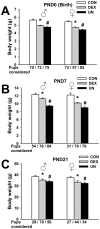Early metabolic defects in dexamethasone-exposed and undernourished intrauterine growth restricted rats
- PMID: 23166830
- PMCID: PMC3500352
- DOI: 10.1371/journal.pone.0050131
Early metabolic defects in dexamethasone-exposed and undernourished intrauterine growth restricted rats
Abstract
Poor fetal growth, also known as intrauterine growth restriction (IUGR), is a worldwide health concern. IUGR is commonly associated with both an increased risk in perinatal mortality and a higher prevalence of developing chronic metabolic diseases later in life. Obesity, type 2 diabetes or metabolic syndrome could result from noxious "metabolic programming." In order to better understand early alterations involved in metabolic programming, we modeled IUGR rat pups through either prenatal exposure to synthetic glucocorticoid (dams infused with dexamethasone 100 µg/kg/day, DEX) or prenatal undernutrition (dams feeding restricted to 30% of ad libitum intake, UN). Physiological (glucose and insulin tolerance), morphometric (automated tissue image analysis) and transcriptomic (quantitative PCR) approaches were combined during early life of these IUGR pups with a special focus on their endocrine pancreas and adipose tissue development. In the absence of catch-up growth before weaning, DEX and UN IUGR pups both presented basal hyperglycaemia, decreased glucose tolerance, and pancreatic islet atrophy. Other early metabolic defects were model-specific: DEX pups presented decreased insulin sensitivity whereas UN pups exhibited lowered glucose-induced insulin secretion and more marked alterations in gene expression of pancreatic islet and adipose tissue development regulators. In conclusion, these results show that before any catch-up growth, IUGR rats present early physiologic, morphologic and transcriptomic defects, which can be considered as initial mechanistic basis of metabolic programming.
Conflict of interest statement
Figures






Similar articles
-
Dysregulation of the adipoinsular axis -- a mechanism for the pathogenesis of hyperleptinemia and adipogenic diabetes induced by fetal programming.J Endocrinol. 2001 Aug;170(2):323-32. doi: 10.1677/joe.0.1700323. J Endocrinol. 2001. PMID: 11479129
-
Prenatal nicotine exposure alters early pancreatic islet and adipose tissue development with consequences on the control of body weight and glucose metabolism later in life.Endocrinology. 2008 Dec;149(12):6289-99. doi: 10.1210/en.2008-0361. Epub 2008 Aug 7. Endocrinology. 2008. PMID: 18687784
-
The timing of "catch-up growth" affects metabolism and appetite regulation in male rats born with intrauterine growth restriction.Am J Physiol Regul Integr Comp Physiol. 2009 Sep;297(3):R813-24. doi: 10.1152/ajpregu.00201.2009. Epub 2009 Jul 15. Am J Physiol Regul Integr Comp Physiol. 2009. PMID: 19605764
-
Role of Prenatal Nutrition in the Development of Insulin Resistance in Children.Nutrients. 2022 Dec 24;15(1):87. doi: 10.3390/nu15010087. Nutrients. 2022. PMID: 36615744 Free PMC article. Review.
-
Maternal Nutrient Restriction and Skeletal Muscle Development: Consequences for Postnatal Health.Adv Exp Med Biol. 2020;1265:153-165. doi: 10.1007/978-3-030-45328-2_9. Adv Exp Med Biol. 2020. PMID: 32761575 Review.
Cited by
-
Perinatal stress exposure induced oxidative stress, metabolism disorder, and reduced GLUT-2 in adult offspring of rats.Hormones (Athens). 2022 Dec;21(4):625-640. doi: 10.1007/s42000-022-00383-w. Epub 2022 Jul 18. Hormones (Athens). 2022. PMID: 35843978
-
Precocious glucocorticoid exposure reduces skeletal muscle satellite cells in the fetal rat.J Endocrinol. 2017 Mar;232(3):561-572. doi: 10.1530/JOE-16-0372. Epub 2017 Jan 17. J Endocrinol. 2017. PMID: 28096434 Free PMC article.
-
Developmental exposure to the endocrine disruptor tolylfluanid induces sex-specific later-life metabolic dysfunction.Reprod Toxicol. 2019 Oct;89:74-82. doi: 10.1016/j.reprotox.2019.06.010. Epub 2019 Jun 28. Reprod Toxicol. 2019. PMID: 31260803 Free PMC article.
-
The laboratory rat: Age and body weight matter.EXCLI J. 2021 Sep 23;20:1431-1445. doi: 10.17179/excli2021-4072. eCollection 2021. EXCLI J. 2021. PMID: 34737685 Free PMC article. Review.
-
Fetal growth restriction followed by early catch-up growth impairs pancreatic islet morphology in male rats.Sci Rep. 2023 Feb 15;13(1):2732. doi: 10.1038/s41598-023-28584-2. Sci Rep. 2023. PMID: 36792668 Free PMC article.
References
-
- Vuguin P, Raab E, Liu B, Barzilai N, Simmons R (2004) Hepatic insulin resistance precedes the development of diabetes in a model of intrauterine growth retardation. Diabetes 53: 2617–2622. - PubMed
-
- Tapanainen PJ, Bang P, Wilson K, Unterman TG, Vreman HJ, et al. (1994) Maternal hypoxia as a model for intrauterine growth retardation: effects on insulin-like growth factors and their binding proteins. Pediatr Res 36: 152–158. - PubMed
-
- Eriksson UJ, Jansson L (1984) Diabetes in pregnancy: decreased placental blood flow and disturbed fetal development in the rat. Pediatr Res 18: 735–738. - PubMed
-
- Jimenez-Chillaron JC, Hernandez-Valencia M, Reamer C, Fisher S, Joszi A, et al. (2005) Beta-cell secretory dysfunction in the pathogenesis of low birth weight-associated diabetes: a murine model. Diabetes 54: 702–711. - PubMed
Publication types
MeSH terms
Substances
LinkOut - more resources
Full Text Sources
Medical

